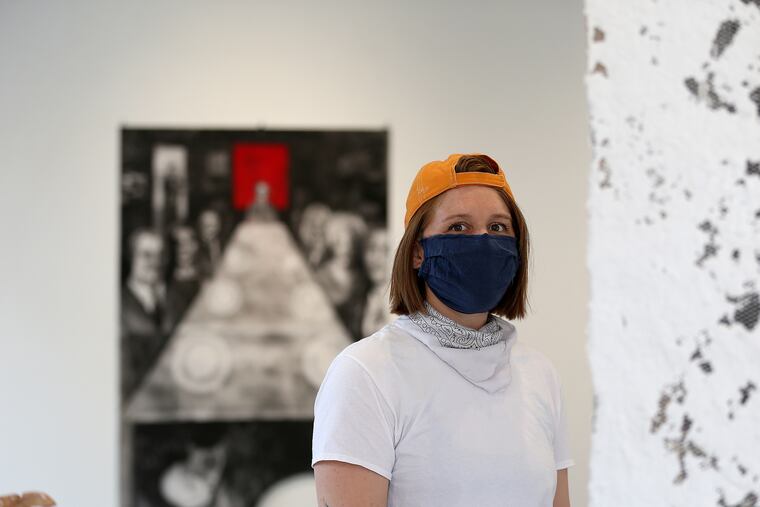PAFA grads boycott their own student art show while trustees pledge to increase diversity
Instead of a grand show in the ornate galleries designed by Frank Furness, the boycotting students are holding a group exhibition at four galleries in an old industrial building on North 11th Street.

Even as the board of directors of the Pennsylvania Academy of the Fine Arts has been holding “listening” sessions with students and alumni in an effort to come to grips with the Black Lives Matter era and its impact on PAFA, events have outpaced the institution.
About a dozen students who graduated this past academic year have come together to boycott PAFA’s annual student exhibition — the culminating event of their early careers and a fundamental rite of passage into the world of art. More than 50 students total were eligible to exhibit.
Instead of a grand show in the ornate galleries designed by Frank Furness in the museum at Broad and Cherry Streets, the boycotting students are holding a group exhibition at four galleries on the second floor of an old industrial building at 319 N. 11th St., invited by the galleries to show there. The exhibition, which amounts to a kind of salon des refusés soi, opened over this past weekend at Grizzly Grizzly, Automat, Practice, and Pink Noise Projects, and runs through Sept. 27 by appointment.
The boycott comes after more than two months of board consideration of what to do in the wake of an early-June letter sent out by PAFA administrators to faculty and staff “reminding” all not to associate PAFA with public statements and BLM petitions. That, in turn, led to a major blowup and demands from students and alumni for deep structural change at the institution.
An online petition, signed by more than 1,000, called for wholesale structural change at the institution. The firing of David R. Brigham, PAFA president and chief executive, was a top priority.
Brigham offered his resignation to the board, which refused to accept it.
The board then formed a committee and has listened to comments from alumni and students covering a range of issues from diversity to sexual harassment. Monday it issued its first community-wide “message” — a kind of brief report — regarding “PAFA’s commitment to a safe, equitable, and inclusive environment.”
The boycotters were not greatly impressed.
“They’re not really committed to doing anything,” said multimedia artist Autumn Casey, who graduated with her M.F.A. degree this past spring and whose work is being shown at Practice gallery. “They’re not being really held to anything.”
Promises and pledges and task forces are not enough, she said, a sentiment echoed by another boycotting M.F.A. graduate, painter Tess Wei.
“They have yet to take any action,” Wei said. “We just get emails, and, you know, special committees and listening sessions. And I don’t know if they think we’re goldfish. But it doesn’t get anything done. And … we are not going to stand for it.”
Casey said that “in those listening sessions, the board members, they don’t even speak. They just sit there in silence. It was just extremely disappointing and sad, because it doesn’t really seem like they even understand what needs to happen.”
The message sent Monday by the board to students, alumni, faculty, and others with PAFA associations promised that the board would review all “hiring practices” in the future and “institute best practices in the hiring and retention” of a diverse staff.
It said it would “continue our commitment to a diverse board of trustees.” There are six trustees who are people of color on a board of 50, according to Brigham, the head of PAFA.
The board’s message did report that last month PAFA hired its first director of diversity.
“What the takeaway is, is that we had to put some refinements to the institution from teaching, and the curriculum, making sure it’s diverse,” said Reginald Browne, one of the four Black trustees and the board member who chaired the committee. “We found out that — we knew this already — that the teaching body, the faculty, was not diverse, but the population is. And you know that that was an issue. So we’re going to correct that.”
Why is there not more diversity on the board? “There is representation on the board of a faculty member and a number of women,” he said. "To the point around actual people of color, that has been a strategic initiative of the board for a number of years.”
Browne said the board is on the lookout for more Black members. "It’s not like we don’t have a desire to” add more people of color, he said.
Those PAFA alumni who authored the petition calling for major restructuring said that the message of the board was far from enough.
“The PAFA administration has not met the challenge of change,” the group said in a statement.
“The administration and board members suffer no penalties nor are they held accountable,” the statement said.
“Their messages read as heavily coached empty gestures. Their few action-oriented claims are offensive in their outdatedness, their calculated shortsightedness, and lack of timelines. … It is clear that the PAFA board and administration ignores the voices of students, faculty and alums, as well as the 1,000+ community members who signed at Changeatpafa.com.”
Browne said that the board review of policies and practices might take 18 more months.